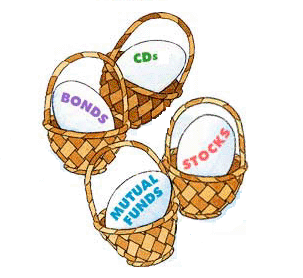The set of all securities held by an investor is called his investment portfolio. The investment portfolio may contain just one security. However, since in general no one puts all one’s eggs in one basket, it will contain several securities. Such an investment portfolio is knows as a diversified portfolio.
An investment portfolio can be classified in the light of following factors such as objectives, risk levels and the level of diversification.
Investment Portfolios based on Objectives
On the basis of objectives sought, a portfolio can be income portfolio, growth portfolio, mixed portfolio, tax savings portfolio or liquidity portfolio.
- In income portfolio, the objective is maximum current income. Small investors, investors whose current income needs are high like pensioners and unemployed persons, persons with lower tax brackets prefer income portfolios. Here the portfolio generally consist of fixed income securities like debenture/bonds/income mutual fund/equity with continuous dividend-record.
- Growth portfolio stress on capital gain. Big investors, high earning professionals and persons in the higher tax brackets prefer this portfolio. Growth mutual funds, growth shares, etc. are included in the portfolio.
- Mixed portfolio give moderate preference for both return and growth. Salaried persons and middle income investors prefer this portfolio. Here the portfolio consists of securities like debentures/bonds, convertible debentures, growth as well as income mutual funds, growth shares and on.
- Liquidity portfolio emphasis on easy offloading. Frequently traded securities (with many quotations on a single day in stock exchanged), gilt-edged securities, buy-back securities etc. are included in the portfolio.
Investment Portfolios based on Risk Level
On the basis of level of risk portfolio may be aggressive (high risk), moderate (medium risk) or conservative/ defensive (low risk).
- Investor interested in assuming high risk go for aggressive portfolio. They may select securities which are having positive correlations between them. The may be rewarded in proportion to the risk they take. Aggressive portfolio have beta coefficients greater than + 1. Beta coefficient is a measure of risk. Market folio (consisting of security of majority of companies) is said to have a beta of 1. So a beta coefficient of more than +1 means higher risk than the market.
- Moderate portfolio have risk more or less equal to that of the market portfolio. The beta of such portfolios is in between +1 and 0.
- Conservative portfolio have far lesser risk than the market. Their beta coefficients are close to zero, say +.05 .Conservative portfolio will have a high load of risk free investments like bank deposits, govt. bonds etc. Aggressive portfolios scantly include the above and contain mostly equity and convertible debenture.
Investment Portfolios based on Diversification Level
On the basis of level of diversification, portfolio can be classified into highly diversified, moderately diversified and lowly diversified.
- High diversification may be taken to mean that the portfolio has over 20 different securities in the kit.
- Moderate diversification includes 10-20 securities in the kit and low diversification means that less than 10 securities in the kit and
- Low diversification means that less than 10 securities are in the kit.
High diversification, if properly done, reduces the un-systematic risk to zero. In moderate diversification means substantial un-systematic risk is present in the portfolio. As number of securities increases, un-systematic risk reduces and hence total risk reduces. Beyond 20 securities, risk remains the same, as the systematic risk cannot be reduced. When you have more than say 25 securities, your portfolio is called ‘superfluous’ portfolio, indicating that it is diversified more than enough.
